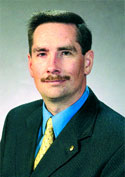
Features
Codes and standards
Hot topics
NFPA Impact: Fire service must respond to lack of statistics
One of the greatest hurdles in effecting change in fire safety in Canada is the lack of reliable statistics. Anyone who attempts to use the available statistics is dealing with little information, out-of-date data and data of little value in comparing performance among the provinces. This makes it more difficult for the fire service to convince others of its value to public safety.
 One of the greatest hurdles in effecting change in fire safety in Canada is the lack of reliable statistics. Anyone who attempts to use the available statistics is dealing with little information, out-of-date data and data of little value in comparing performance among the provinces. This makes it more difficult for the fire service to convince others of its value to public safety. As a nation, we need to do a better job in collecting fire-loss statistics. The problem and the solution lie in the hands of the fire service.
One of the greatest hurdles in effecting change in fire safety in Canada is the lack of reliable statistics. Anyone who attempts to use the available statistics is dealing with little information, out-of-date data and data of little value in comparing performance among the provinces. This makes it more difficult for the fire service to convince others of its value to public safety. As a nation, we need to do a better job in collecting fire-loss statistics. The problem and the solution lie in the hands of the fire service. National statistics are available on the Canadian Council of Fire Marshals and Fire Commissioners website (www.ccfmfc.ca ). Unfortunately, the most recent national statistics are from 2002 and even they are incomplete. These statistics are prepared by Fire Protection Services, Human Resources and Social Development Canada and compiled from information supplied by the provinces, Indian and Northern Affairs Canada (INAC) and Statistics Canada. The compilation of the data is an exercise in frustration for HRSDC, as often the data is unavailable and, when it is available, needs to be massaged into a common reporting framework. The statistics are the best available but they should never be mistaken for an accurate picture of the fire scene in Canada. The data that is presented includes a number of anomalies and is therefore almost useless for making comparisons. This has proven detrimental to the fire service when we have argued for better fire-protection standards.
Some evidence of the anomalies is found when comparing the numbers of reported fires by province. One would expect there to be some degree of uniformity in the per-capita stats but according to the 2002 numbers, there were twice as many reported fires in Saskatchewan per capita as in Alberta! The same holds true in the Maritimes, where New Brunswick reported twice as many fires as Nova Scotia. According to the available statistics, both Saskatchewan and New Brunswick had between 2.4 and three times more fires per capita than Ontario. I don't believe that this represents reality. Fires do not spontaneously occur at a greater rate in rural locations. If they did, how would we account for the New Brunswick and Nova Scotia discrepancies given that the standards of building design and the basic fire-prevention programs are the same. Instead, it seems logical to assume that the fire statistics are not being reported accurately. If one considers the rates in New Brunswick as closer to the norm, then the number of fires not being reported could easily be as high as 40 per cent nationally.
The problem is well known and has been studied by the Canadian Association of Fire Chiefs, IAFF and the Canadian Fire Marshals. The CCFM&FC has held ongoing discussions on the subject and is working on the issue. The CAFC has highlighted the reporting deficiencies as another justification for a National Fire Service advisor. However, I disagree that having such a person in Ottawa will solve the problem as there is little that one staffer can do to hasten non-existent fire reports. Simply put, we're to blame. The reports are not being generated by the fire service regardless of whether departments are career, paid on call or volunteer.
The problem is that there is little appreciation by the fire service for the value of the statistics. As it stands now, much of the data that is available is suspect and therefore few conclusions can be drawn from the numbers. This may ultimately lead to our inability to effect change in the fire and building codes. Without reliable data, it is easy for those who oppose safer standards to dismiss the demands of those who endorse them. We do not have a credible means of reporting. Once the fire service can buy into the need for reporting statistics we can look to the greater challenge - providing relevant statistics. The police services have excellent means of tracking statistics and therefore have been getting progressively greater resources. Lack of reliable statistics is hurting the fire service.
A familiar expression in computer programming is "garbage in equals garbage out." This holds true for fire service statistics. We need the fire services to begin to consistently submit fire reports. Once we have developed this capability we can look to use new tools to show the true value of the fire service to Canadians.
Sean Tracey, P.Eng., is the Canadian regional manager of NFPA International and formerly the Canadian Armed Forces Fire Marshal. He may be reached at 613-830-9102, e-mail stracey@nfpa.org .
September 14, 2015
By Sean Tracey
Print this page
Advertisement
Stories continue below
Related